Text
Infographic - Mental Health Awareness

Sources:
https://clearhealthcosts.com/blog/2013/12/much-mental-health-care-cost-part-2-finding-affordable-psychotherapy/
https://www.nami.org/Learn-More/Mental-Health-By-the-Numbers
http://www.mentalhealthamerica.net/issues/2016-state-mental-health-america-report-overview-historical-data
https://www.time-to-change.org.uk/mental-health-statistics-facts
0 notes
Text
Distancing
There is a sense of distance one can see within themselves and others. On social media, we often represent ourselves in a different way compared to reality. Representation of oneself on social media can create a distancing effect that divides certain aspects of our identity. With this idea in mind, I explored the realm of perception vs. reality on social media. I used both Facebook and Swiflie as resources to gather information and build rapport with anonymous and (attempted to with) familiar faces.
I began the process by using an anonymous social media app to ask people how they represent themselves online. The anonymous app was fruitful and produced colleagues that were open, accepting, and willing to collaborate on this project. Facebook was less successful because the sense of anonymity was not there. The people I attempted to work with were not as open as those on Swiflie. The following images and video are collaborations between the anonymous users and I. We discussed how we tend to represent ourselves on social media. I received permission to use direct quotes from out conversation to create a visual representation of the perception vs. reality identities. The collaborators in each image are anonymous to me and to those who view this. The anonymous collaborators assisted me in formulating an approved and accepted the portrayal of their media representation and reality.
vimeo
“I post pictures and videos on my facebook page of me doing typical man activities involving sports and cars and whatever else I think of to give my family back home the impression that I’m just a man and not someone who identifies as female”
Both the collaborator and I came up with this video to display the social media representation vs. reality. I was given permission and the okay to proceed with this video clip and quote after my collaborator reviewed it.
vimeo
“I post pictures of food to my IG, snapchat and facebook to show people that I eat more than I do. I have an eating disorder I don't share with people.”
The collaborator and I came up with this video to highlight their social media representation vs. reality. I was given permission to post this representation and quote after review and approval.
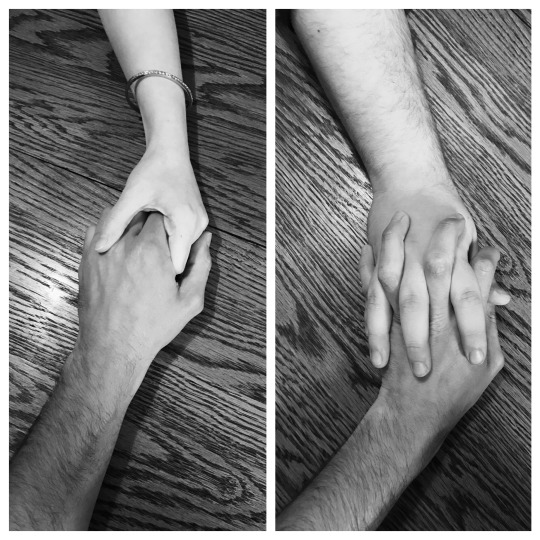
“I have a friend that's a girl she pretends to be my gf on fb so my parents don't find out I'm gay. I come from a family that is religious and conservation and not accepting so I have to hide who I'm actually dating online.”
My collaborator and I came up with this idea based on an Instagram picture he described posting. The picture was of him and the girl he mentioned holding hands at dinner. I received permission to post the image and quote after review and approval.
vimeo
“I blast that I am caffeine addicted all over social media like any other young adult would and people in my personal life always comment on my shaky and jitters. They make jokes about me being hooked on something besides caffeine. They are right I'm addicted to pills that keep me alert and not caffeine. I post about coffee to not cause suspicion.”
My collaborator and I decided that a video would best serve this instead of a picture. We made the decision to depict someone performing what is pictured in the video as it is similar to what he does with his morning coffee. I received permission to release the quote and video after review and approval.
Overall, this process was difficult to navigate and my expectations were flipped when I received more collaboration from an anonymous app compared to people I know and interact with frequently. The sense of anonymity opened up discussion and produced collaborative representations of ones social media representation vs. reality. I agreed to send the final post to those involved so they could review and pass it along if they feel comfortable doing so. one can see the sense of distancing from self through social media. This project was inspired by John Berger’s Ways of Seeing and representation; it was also inspired by the sense of distance Cannibal Tours depicts in the opening scenes. I used both of those inspirations to apply it to social media representation and used collaborations between anonymous user to depict the sense of distance they show on social media.
0 notes
Text
Mobile App Walking Tour - How I Distract & Conquer
For the Mobile App Walking Tour, I chose to focus on my experience with mental illness. I was inspired by the Distract & Conquer piece from the CVSN 2012 edition reviewed for one of my media journals. I creatively misused Hannah Schulte’s idea of distracting and conquering feelings of anxiety through media consumption and applied it to how I distract and conquer my anxiety with physical spaces. When I feel like I need to isolate myself, I turn to the places and spaces that provide the distraction I receive from playing video games or binge watching Netflix. I hope you enjoy the insight into my methods of distraction, conquering, and physical space related to anxiety and depression.
https://izi.travel/browse/8c350982-f9e4-4587-b749-714d56e624b4/en
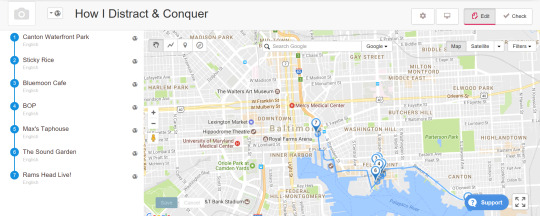
A screenshot of the Mobile App Walking Tour: Distract & Conquer

A screenshot of the Mobile App Walking Tour: Distract & Conquer
0 notes
Text
Ethnographic Photo Essay - Distract & Conquer
For my Ethnographic Photo Essay, I chose to create a narrative that compliments the Mobile Walking Tour App. For the Walking Tour, I focused on public spaces and places that go along with divide and conquer. Since those were all public ways of distraction and conquering manifestations of mental illness, I wanted to display the intimate ways I achieve distracting and conquering those feelings. Most of the pictures are media related which goes along with the CVSN 2012 issue I reviewed for my media journal.
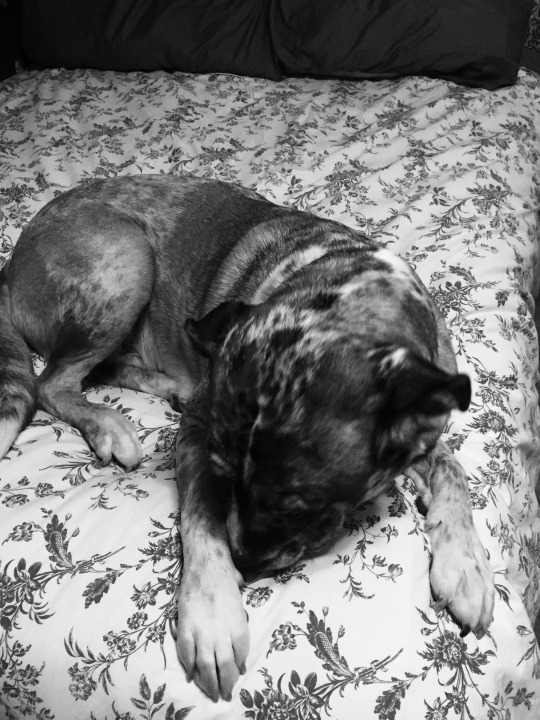
The first photo shows my bed as well as my dog, Blue. I chose my bed as the first subject in my intimate version of distract and conquer because I spend a lot of time here because of depression. I find sleeping it off a good way to distract myself from what my depression manifests.
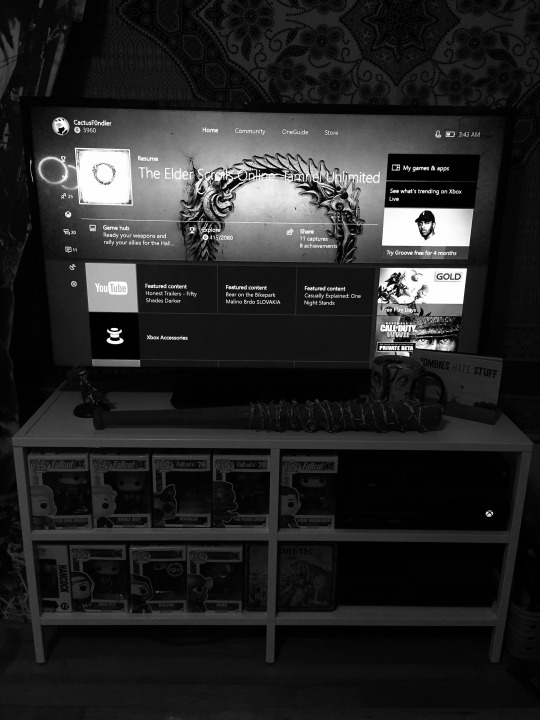
My second image shows the main media outlet I distract myself with. My Xbox has the ability to make me forget time and clear the negative thoughts out of my head. I spend a lot of time playing video games as a way to distract my from my thoughts and drown out the noise.

The third picture shows a part of my comic and book collection. I read various comics and books as a form of distraction and conquering through literary characters.

The fourth image shows Blue again. I take him for walks almost every other day but especially when I begin to manifest the feelings associated with depression. I feel Blue hassles me to give him a walk when I’m in that state of mind.

The fifth image shows the third most used media item for distraction. YouTube is place where I can find comfort on any topic I can imagine. I watch mostly gaming videos because the few channels I watch really bring my mood up. I think its also important that those channels I watch constantly bring up mental health awareness to their audience.

The sixth image is something that is always in my hand or pocket. It is a aquarium game that provides anxiety relief when I am at home or in public. Its a giant aquarium you control which gives someone with anxiety control over something in a sea of stressful and expanding thoughts.

The seventh image shows one of my makeup storage spaces (the other was far too messy to picture, oops.) Makeup is a distraction from the feelings in my head because it gives me control and a task that is finished everyday. I also believe if I make myself appear better, I feel better. Fake it till you make it, I guess.
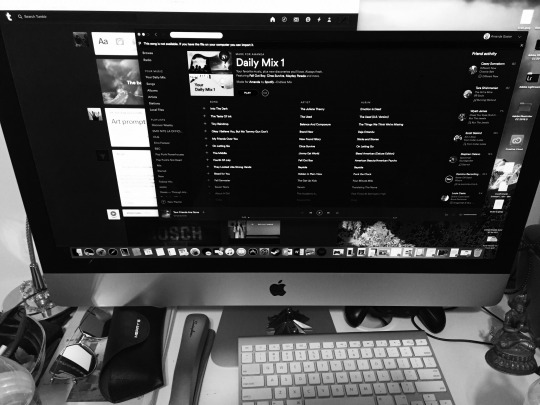
The eighth and final image shows my Spotify account which is also constantly used. Music is a hug benefit to someone with anxiety and racing thoughts. It allows me to distract myself and focus on words and sounds.
0 notes
Text
Data Visualization - Hashtags Used for Mental Health Awareness
For the data visualization portion of the media portfolio I used SocioViz to create multiple images of word links associated with mental awareness hashtags popularly used on Twitter. The process of this was interesting as I found people discussing mental health issues that I face and don't talk about on social media. The word associations and conversations linking users to each other and me, encourages me to have a more active voice on mental health awareness on social media. Below you will find the data visualizations pulled from Twitter.

#mham2017 from Twitter analysis
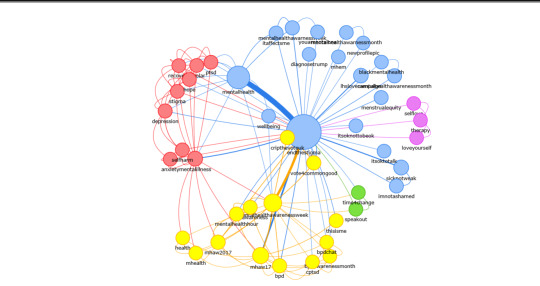
#endthestigma from Twitter analysis
Instagram in the past few days launched a campaign called #HereForYou which promotes mental health awareness. When someone uses the #HereForYou they share their struggles with mental illness promoting an active voice and fighting the stigma associated with mental health. Instagram also made tools available to alleviate the negative implications from social media such as hurtful Instagram comments. Instgram provides a way to anonymously report violators and disable comments on a post. One of the impressive things about the campaign is the hashtags ability to connect you with resources and people that know your struggle. Here is the record of geotagged posts on Instagram:
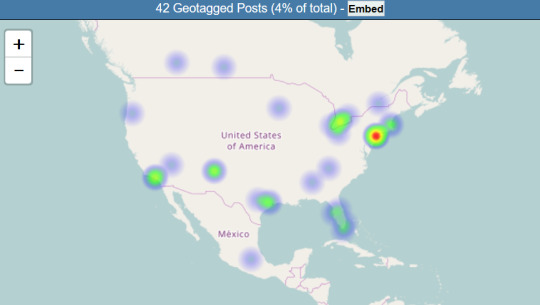
#HereForYou from Instagram
1 note
·
View note
Text
Photo Elicitation
Questions about the reading:
What is the definition of photo elicitation?
Photo elicitation is inserting a photograph into a research interview. Doing this small action creates more meaningful and qualitative responses from participants. The image connects with a person more so than words on a page; evoking symbolic representations and deeper elements of oneself.
When and how was photo elicitation first used as a methods?
Photo elicitation was first used for research purposes by photographer and researcher, John Collier. Collier implemented the use of photographs in an interview session to elicit meaning responses for researchers facing difficulties.
Identify and describe the four areas where photo elicitation has been concentrated.
Photo elicitation has been concentrated in Social Class, Community, Identity, and Culture Studies. The social class includes studies of familial photographs that show social life produced by participants. Community utilizes photographs to study gentrification and how urban residents keep their sense of identity. The identity uses photographs to examine different dynamics of social identity and how populations mark themselves. Finally, Culture and photo elicitation aim to interpret the signs of cultural institutions and works as a means for grounding cultural studies.
How does Harper discuss the notions of “break the frame” and "building a bridge"?
Breaking the frame refers to the idea that an image can elicit deep reflections and break through the participant's normal lens, making the interview a more reflexive and collaborative process. Building a bridge refers to using the collaborative nature of photo-elicitation to build a commonality between to different people over photographs; creating a unified meaning and collaborative experience.
Answer the Following interview questions yourself.
What do you think of the City of Baltimore?
I think the City of Baltimore as my home. I grew up not too far outside of the city, and my mom worked at a law firm a few blocks away from the Inner Harbor. I’ve seen the positive and negatives of Baltimore but it has not skewed my Charm City-like image I hold.
What do you think people outside of the city think about Baltimore? Regionally? Nationally?
Due to the representation bias produced by the media and certain television series, I believe most people have a misinterpretation of Baltimore. Therefore, most people outside of Baltimore, locally, regionally and nationally may not see Baltimore in the best light. The images of Baltimore in a simple google search produce images that tell a destructive and violent narrative that most people blindly accept (without question why certain things happened - and ultimately, perform victim blaming).
What do you think are the biggest problems facing Baltimore?
Well, one of the huge problems are the institutions that facilitate a cycle of poverty and gentrification among populations in the city, and ultimately ignore their concerns for better living situations, education, and other factors. The other problem is the representational burden placed upon residents of Baltimore City which can discourage assistance and reinforce stereotypes assumed by those outside of Baltimore.
What are the reasons Baltimore faces various problems like these?
A long history of structural violence, representational bias, victim blaming (and not questioning the structural forces at play), and gentrification.
The 10 Images I chose:
1.Pg 1: Lawrence by Julie Stovall Lauver, I like seeing the person behind the camera as it makes the setting more reflexive (and sets the tone for the book)
2. Pg 6: The silence breeds injustice photo by Tyson Sanford-Griffin, the message on the poster say it all.
3. Pg 10: Penn North & Vacant Homes by Mason Alston, the photo shows two comparisons of Baltimore city streets. This could reflect the beautification of one’s neighborhood too.
4. Pg 15: Melia by Madison Mohan and Penn North by Enoch Free Library, both photos show another striking comparison of two different neighborhoods. You can see evidence of violence.
5. Pg 16-17: Taleah by Amiyah Spraggins, this photo was extremely eye catching because of the pop of color on both pages. I like the frame of the shot and how the subjects gaze meets the plant.
6. Pg 18: Tykwan* by Zachary Guy, this photo breaths strength and power through the body language of the subject and the angle of the camera.
7. Pg 19: Chance by Zachary Guy, I like the style of this photograph and how the subjects image cast a great shadow on the mural behind him.
8. Pg 29: Ju’Nore by Zahi Habeebullah, the subjects pose and facial expresses tell me that he was being silly. I enjoy the comical pose in this one.
9. Pg 62: Michael by Imani Morgan, I like the subjects posture and facial expression and the quote next to him.
10. Pg 63: Imani by Raymond Richardson, the subjects facial expression is telling and his hand gesture is telling me to think more about what is around you.
The Interview:
What do you think of the City of Baltimore?
“The City of Baltimore is a hard, grimy, unique city, rich with history, and filled with character that is unlike anywhere else. It can also be an extremely tough place to live.”
What do you think people outside of the city think about Baltimore? Regionally? Nationally?
“I think people think of the city much like I stated above, but with more emphasis on the darker “hard and grimy” side of things. Shows like The Wire have done a lot to paint people’s picture of their perception of Baltimore, but I don’t necessarily think it’s inaccurate either, it just simply focuses in on one facet of what the city truly entails, and doesn’t tell the full story. Regionally, when I tell certain friends from other parts of this region that I’m from Baltimore, they’re all like “Woah..” and assume I “live in the ghetto.” Nationally, I think Baltimore has the reputation of being one of the most “hardcore” cities in the country, with not only things like The Wire perpetuating this reputation, but even the established persona of the Baltimore Ravens, and the widely known statistical facts of Baltimore’s murder rate. The recent Baltimore riots have cemented this national reputation even further.”
What do you think are the biggest problems facing Baltimore?
“Extreme racism, division, poverty, economic inequality, outdated infrastructure, highly inflated housing market, oh and the weather sucks too! I’ve heard many people who have lived in other areas in America before living in Baltimore say that Baltimore’s racism and social/economic/racial division is incredibly blatant and unlike anywhere else in America. They say that our racial status is like we’re still living in the 60’s.”
What are the reasons Baltimore faces various problems like these?
“I think the problem stems largely from simply the foundation of our country being established from the beginning as a white supremacist nation, ruled by a rich, white elite, who have established a systemic racism and an economically unequal system from day one that is designed to perpetuate those conditions further and further as time goes on, and because of the large percentage of poor black people concentrated in this city, the racism and division is even more highlighted and pronounced by the white elite who run the place than in other areas. When Baltimore was founded as a city, there were literally lines dividing which areas were for whites and which were for blacks, and even after “segregation” was abolished (so they say), these lines of division still exist to this day, and that is why one driving through Baltimore can go from an all-black area to an all-white area, night and day in their differing economic conditions, in as quickly as two minutes. The cycle of poverty is hard to break out of when the system you’re stuck within does little to nothing to help uplift these conditions, and in fact does more and more to make them much worse (mass incarceration, police brutality, neglected infrastructure and housing projects, lack of new employment opportunities, etc). These problems won’t be fixed until a MASSIVE revolution takes place with the governing powers within this city.”
The 10 Images Brandon Chose:
1. Marqueise by Jeffrey Obike – “Interesting, because his sign says Black Lives Matter AND it says All Lives Matter, showcasing the obvious fact that BOTH of these positions can be held simultaneously.
2. Mason by Faith Goodwin – “Fists in the air are awesome, and the handcuffs on this fist, free from any apparent bondage, are a powerful touch.”
3. Chance by Zachary Guy – “I like the shadow that the boy finds himself standing within.”
4. Makai by Deonte Stanley – “Woah, he’s floating.”
5. Metaphorical Self-Portrait by Deonte Stanley – “Woah, it literally looks a person holding their hands up..”
6. Quentin by Maliyah Baldwin-Bey – “Hell yeah, basketball!”
7. Lenny by Latrell Leverette – “Yesss, more basketball!”
8. Latrell by Lenny Johnson Jr. – “Basketball and books, story of my life!”
9. Robert by Naje’ Tate – “Cool image, and piano is my favorite instrument!”
10. Raymond by Imani Morgan – “Awesome how the reflection of a painting is shown on the floor, looking almost like it’s on water.”
Reflection:
The entire process was comfortable and free flowing because the partner I chose was extremely verbal (as I am not, I speak better through written words). My collaborator understood the violence against Baltimore and recognized the bias in media portrayal of the city. However, he leaned more towards the acceptance of negative images as I do not. This made for an interesting debate between two friends. When talking about Baltimore’s problems, he mentioned the racism being the leading factor of the issues Baltimore faces. When we discussed the reason Baltimore faces these issues, my collaborator mentioned mostly how gentrification divides a clear line between black and white neighborhoods that perpetuates racism in out City. I added to the conversation y discussion how poverty makes someone regionally imprisoned. The questions were preliminary and got heated at times (I am by no means a confrontational person whatsoever, so the debate's hard for me to preform), but it was a rewarding experience.
The photograph portion was my favorite part because I am extremely visual. I make sense and meaning of things easily through images as opposed to word. My collaborator is no the same way. He did not feel comfortable in the interview process or the photo elicitation process; I think this is due to the power dynamic usually experienced in our friendship. Since I am quiet and the opposite of assertive, it was hard for him to react to me in that role. I think this hindered the conversation on his part of the This Is Baltimore book portion. My collaborator's comments were very much surface level; he more so analyzed the content of the image rather than the meaning. This is where I did not break the frame because I do not think we made a meaning full connection through the images or build a unified idea on a picture. However, I believe the book aided my interpretations of Baltimore as a city more than its media representation. For my collaborator, I’m not too sure if it did or did not.; I hope it helped him see the alternative representations of Baltimore.
0 notes
Text
Flipping the Script & Cannibal Tours
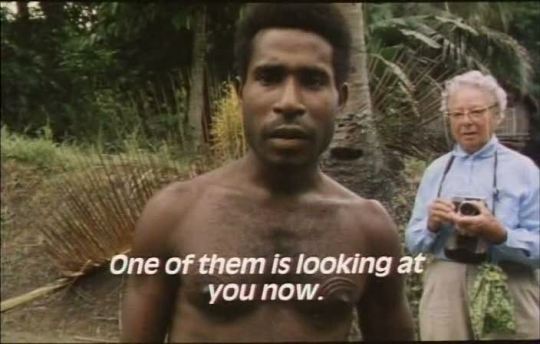
What groups are being essentialized in the ethnographic film?
In the beginning, it appeared as if the “other” was the focus of the film. However, further visibility suggests Westernized tourism and exploitation of “primitive” people becomes the focus. The cannibalism depicted in the film does not come from the ethnocentric assumption of those who have a different way of life. The ethnographic film becomes a tool to showcase the wealthy European and American tourists and ecotourists, who dehumanize, cannibalize, and consume indigenous people and their culture.

What does MacCannell mean by the term 'ex-primitive'?
MacCannell refers to the line that is drawn between the terms “primitive and ex-primitive.” MacCannell associates the word “ex-primitive” with a group of people that in the past were declared as the other and primitive. Macannell’s terminology of ex-primitive by being forced to adapt quickly to modernity after being exposed to colonial exploitation, suppression, and tourism.
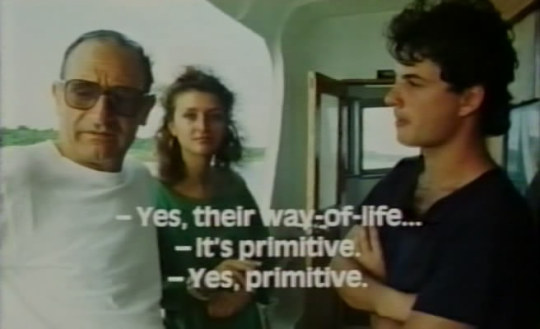
What is the touristic ideal of a 'primitive' and how is that witnessed in the film?
The touristic model of a “primitive” is a fantasy associated with cannibalism, raiding, and painted in “native fashions” while displaying performative acts. The primitivist fantasy is related to the obsession that Western tourism and modernity. You see this obsession in the film by the tourist photographing and ultimately exploiting the Sepik River lifestyle and its people; while this is occurring O’Rourke points the lens at the tourists and reenacts the same exploitation with his cameras, conveying the tourist's primitive fantasies and consumption of culture. O’Rourke strengthens this way of seeing tourists by utilizing black and white imagery connecting it to early colonialism photographs.
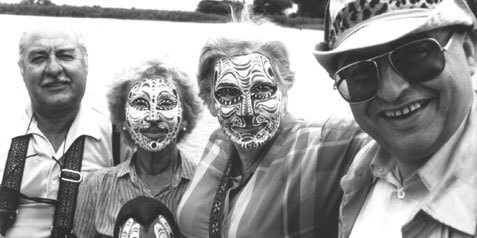
What is your overall assessment of the film?
The film's construction flips the script with exotification of the “other.” As a viewer, without prior research, you assume the indigenous peoples will be the focus of the ethnographic material. However, with further visibility of the tourism associated with exploitation, modernity, and commodification that comes from Westernized obsessions of primitive fantasies and cultural cannibals. The camera has used a weapon to point and document the exploitation of the exploitation. The actions from the tourists are the true cannibalism that occurs in the film and not the “primitive” actions of westernized images of indigenous people.

Cannibal Tours share a familiarity with tourism that happens in the same way in Brazils favelas that is also exotifying, exploiting, and commodifying the “other.”
1 note
·
View note
Text
The Canon: Robert Gardner Media Journal
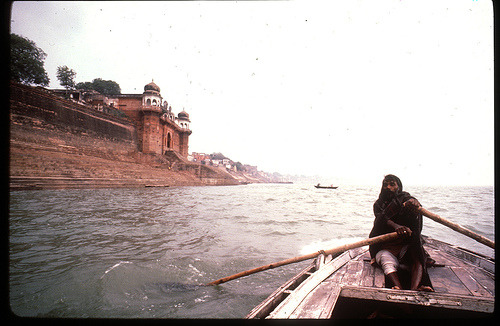
Is Robert Gardner an ethnographic filmmaker or visual artist? Does it matter when attempting to document culture?
According to Ruby, Gardner’s work leans more towards visual artistry. However, Ruby does credit Gardner’s work as a contribution to ethnographic film through Dead Birds and his assistance with The Hunters. Although this contribution does involve ethnographic film, it does not justify the title of an ethnographic filmmaker because Garner does not follow practices of cultural anthropology theory. Gardner’s content tends to focus on cinematic elements, preconceived ideas, and representations he wants to showcase through “exotifying the other.” When attempting to document culture, capturing the authenticity of culture is problematic as a filmmaker, whether he or she identifies as a visual or ethnographic artist. Individuals portray different personalities in front of the camera, and it's hard to capture culture authentically to produce and represent an original way of seeing an unfamiliar culture. If one proceeds past this barrier, while utilizing an anthropological lens, I don’t believe there is significance whether or not someone identifies as an ethnographer or visual artist.
What are Ruby's main critiques of Robert Gardner and his films?
Ruby reviews Gardner on two factors:
• Gardner does not follow the theoretical practices of modern cultural anthropologists
• Gardner does not organize his films through anthropological knowledge from ethnographic films
• Ruby seems to suggest the aura or persona attached to Gardner is problematic – this can be evident through the achieved status of “founding father of ethnographic film.”
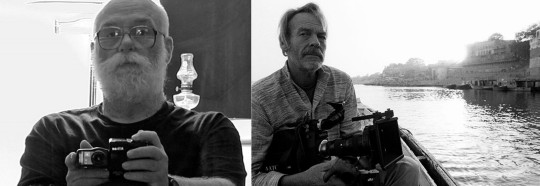
“It is therefore essential that a critical examination of his work be undertaken. I find his work problematic.” – Ruby, 95.
How does the notion of 'salvage' play into the critique of Gardner by Ruby?
The term “salvage” applies to “disappearing cultures.” Gardner attempts to rescue and preserve the cultural knowledge and information of a culture that is, in his opinion, fading from existence. Not only is the attempt to “salvage” a culture theoretically problematic, but offensive and unethical towards that particular culture. Ruby includes that Dead Birds was a salvage ethnography project from Gardner and associates.
“They all felt the urge to filmiely salvage some of the cultures that were presumed to be disappearing.” - Ruby, 97.
What are the direct critiques of Forest of Bliss by Ruby?
Ruby directly critiques Gardner’s use of mystification in the film. In Forest of Bliss, the language spoken in unidentifiable to Ruby and does not contain subtitles. To the viewer, those in front of the lens are performing ambiguous conversations and tasks. Gardner’s mystification process here caters to an audience full of experts and excludes others; it is a purposeful action and a misleading aesthetic that exposes the culture to ethnocentric interpretations, ideas, and meanings from the viewer. Ruby furthers this claim by explaining how the importance Garnder places upon the cinematic elements over the cultural capital captured discredits and creates a problematic representation of film participants. One can learn an incredible amount of information based on language and action performed by someone. Gardner’s choice places little importance on communication and daily activities captured in Forest of Bliss. Ruby seems to suggest the mystifying montage is problematic towards the cultures representation and the viewer's way of seeing.
“I attribute meaning that stands a good chance of being accidentally ethnocentric and incorrect because I cannot infer anything about the maker’s intention beyond his aesthetics.” - Ruby, 110.
What is your take on the difference between Ruby and Gardner's perspective on this film?
Gardner focuses on the personal lens and creates films surrounding his intentions. Gardner does not consider Forest of Bliss to be ethnographic and employs what he believes as visual artistry to display a culture in an aesthetically pleasing way. Gardner chooses to focus on his vision and excludes anthropological theory or ethics. Gardner creates a stylized personal film as an artistic representation of culture. Ruby perceives it an ethnographic piece because of the participants involved. Ruby focuses on the anthropological lens which includes anthropological theory and ethics. Ruby actively attempts to avoid problematic representation of cultures and their authenticity.
1 note
·
View note
Text
Design Ethnography Media Journal - Distract and Conquer & The Future: CVSN 2014
The Review:

A screenshot from The Future vol. 2 CVSN 2014 Issue - This image serves to provide a visual example of the colors scheme and theme
The magazine for the student work I chose to review caught my eye immediately. The CVSN 2014 vol. 2 was the most aesthetically pleasing to my way of seeing. Compared to the other options cover page, it stood out amongst them. The way the information is constructed in a “magazine” template is attractive due to its familiarity. The grayscale with a pop of color was an attention grabber. The magazine style presentation gave off an aura of nostalgia that contrasts the futuristic information provided by the students. Not only was it visually appealing, but the content was meaningful to me and provoked critical thought and insight. The way I saw and interpreted the information felt catered to my life and struggles. The piece by Hannah Schulte titled, “Distract and Conquer” combined many factors familiar to my experiences. Anxiety for me is a daily rerun episode of a television show you use to fill the empty space. Coming across this article not only served as informative but made my experiences a little less isolated.

A screenshot of the student work I chose to review from CVSN 2014
The first statement of the article is an attention-grabber, “Anxiety surrounds the future.” This is supported by the reader's personal experiences as well as the examples in the text. After establishing the visibility of anxiety; the author begins shifting the focus to the unknown or “gray areas” (possibly related to the color scheme – pure speculation) that the future may hold. Those suffering from anxiety prepare for this inevitability in different ways; some are culturally sanctioned methods of control and others are stigmatizations viewed as “other.” Schulte leads to the notion that people tend to confront anxiety through viewing practices, it is a form of distraction from their personal fear and takes hold of the problem through another reality. Dominant display methods include binge watching television series, in this case, shows that have characters tackle and control their anxiety. For the viewer, it is both entertaining and comforting seeing similar struggles being played out, almost like insight or advice on how to manage their demons to gain a sense of control. Not only does it provide an outlet for the viewer but also positions the viewer in a power dynamic above those in the television shows. The power dynamic casts the characters as “other” due to their methods of attaining control over their anxiety and fear of the future. Schulte uses The League and Doomsday Preppers as manifestations of this sense of control over one's anxiety, describing the unique or comedic methods of those given the lens. The preparations and methods that those characters practices determine their success rate and control of the anxieties of the future.

A screenshot of a particular heading within Distract and Conquer normalizes distracting tendencies and bring attention to the character traits portrayed in many anxiety filled character
The author relates this to her personal struggles of post-graduate anxiety and the separation of happiness and financial stability probed by her parents. Schulte, in the end, chooses happiness over security creating art that feeds the soul and not her stomach. This was her way of gaining control over her anxiety and unknown future. Schulte also asserts dominance over the ambiguity of tomorrow by educating herself and making sense of missing information. The methods she performs such as viewing other ways people managed their anxiety, teaching herself, and grasping control over her anxiety prep her for the unknowable similar to television characters previously described. This pressure of post-graduate dread is visible in my life. Choosing between happiness and financial stability is an everyday struggle. This separation between happiness and security is also an issue my parents instilled in my mind beginning college. I went in thinking I wanted to be a psychologist realizing later in my academic career that I was putting potential financial security over happiness. The completion of my psychology requirements marked a significant shift in my academic career that would prolong my time her at Towson University. The riskiness of my decision to choose an additional career path and prolonged time at university haunts my mental state, triggering anxiety of potential futures. Finding and reaching out to experts hard physically and socially. I often feel lost and not in control. The lack of control manifests into distraction and viewing practices through video games and television. I find myself in a heroic reality conquering whatever quests come my way through my avatar. Unknowingly, this distraction provides the control over my anxiety, overcoming challenges virtually and visually.
Schulte’s critical assessments of anxiety subdued through media distractions related significantly to my life and made my experiences feel less isolated and alone. Bringing to the light the manifestations of control through viewing practices was unconscious to me. The popular culture references and direct correlation to the fear of the future detailed a plan of action for those suffering from anxiety. Schulte’s way of seeing and connecting distractions, manifestations and personal experience allows the reader to situate themselves within her narrative. My way of seeing my distracting habits has changed from a nuisance to necessary; there is a need to enable yourself to escape your fears and conquer them in an indirect way to alleviate negative feelings. As I continue with my way of seeing a distraction, my demons will forever manifest into the challenging antagonist and my hopes for control will become the protagonist in the virtual world.
Interesting Media Components to the Magazine:

Hannah Schulte, author of Distract and Conquer, provides a game similar to those found in magazines. This represents the multimodality one can create within print media. Schulte utilizes many forms of media throughout her article, pairing words and images that would make Sarah Pink proud. This also only represents her statements concerning television distractions, it provides information and solutions based on what your anxious about and how to distract yourself

I spy an infographic of keywords within CVSN 2014 which also displays the color scheme I touched on in the review

The inclusion of a horoscope section stays true to the magazine theme - this also can represents the obsession over the future and reliance on forms of media for control and guidance

The inclusion of representations of millennials is relevant and genius - it is possible that you hear dominant media outlets and older generations depicting millennials in a negative way - this possibly can be considered a representational burden as a result from dominant media outlets - CVSN 2014 and the future of it can act like ABTW and produce different representations of millennials to stand along side the current representations
1 note
·
View note
Text
The Canon: David MacDougall & “Photo Wallahs” Media Journal
How do the MacDougalls discuss the history of photography in India?
Photography in India has a rich history starting from the initial launch of the field. MacDougall supports the historical content by providing background information based on Indian photographic traditions; Macdougall states the first Indian photographic club was established in 1854 relatively around the time photography was invented. In addition to this establishment, various photographic studios began functioning in the main cities in India and became an art that was visible in everyday life. The photographic movement of India eventually became subjected to power dynamic entangled with a bureaucratic use and source of power. The artistic aspect of photography became an institutional tool for British colonialist, forms of identification, and documentation. Macdougall described the history of photography in India briefly and claimed his focus would be on the contemporary use of photography in India.
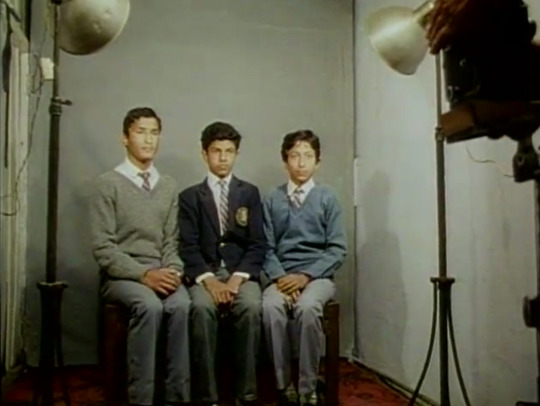
A still image from the film Photo Wallahs
How do they discuss the process?
The process of their research and execution of film quickly changed at the start. Macdougall explains to the reader how his focus changed when research in India began. They sought after a particular type of photographer, a village photographer serving a small community, which was impossible to find. Instead of finding just one photographer in a town, they would find twenty. The shifting lens is quite standard and was mentioned in Dr. Gill’s lecture in class. Many times researchers and ethnographers will enter with a particular topic in mind, and emerge with an entirely different focus after building rapport and exploring the area on interest. This was visible in the Macdougall’s research in India. As they team searched for their “imagined subject,” they became aware of how contemporary photography was being used in India and how differently it was produced. In the film we saw photography used as a mean of commodification and livelihood; photographers were utilizing Indian culture and history to dress and photography tourists like “authentic” cultural representative of India.
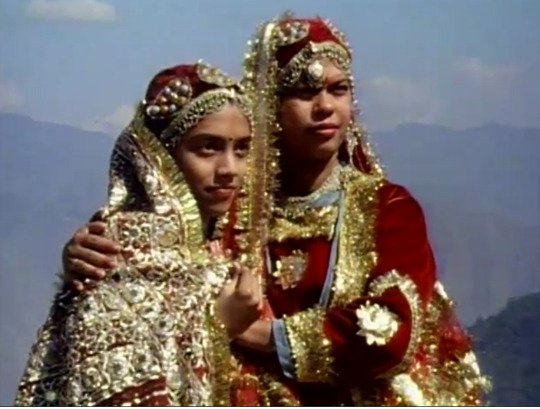
A still image from Photo Wallahs - this image was chosen to display what the commercial tourist photography looks like Stil
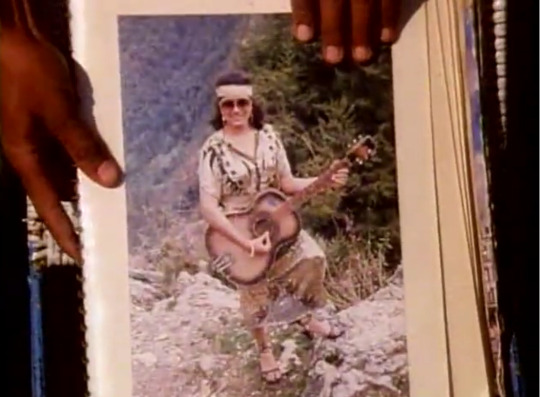
A still image from Photo Wallahs - this image shows a different way of seeing commercial tourist photography and also combines the contrast between still imagery and moving imagery discussed in the reading
Macdougall also mentions the difficulty in using one visual medium to describe and show another. This process creates complexities and opportunities. Individuals act differently when being filmed compared to a still photograph. There is a performative aspect to moving images that elicit a particular reaction and participatory reflex out of the one in focus. Still, imagery is instantaneous, and the one in focus does not have much time to think about it. Both of these examples are seen in the film. With moving images, the participants are aware they are being filmed and welcome it. During the commercial tourist photo shoot, the tourist photographer invites the tourist to dance for the camera and so he performs. The still imagery is seen with various still photographs shown in the film. Not only does the process show this within the film, but also at the end where they contrast still imagery and moving imagery to bring them both together.
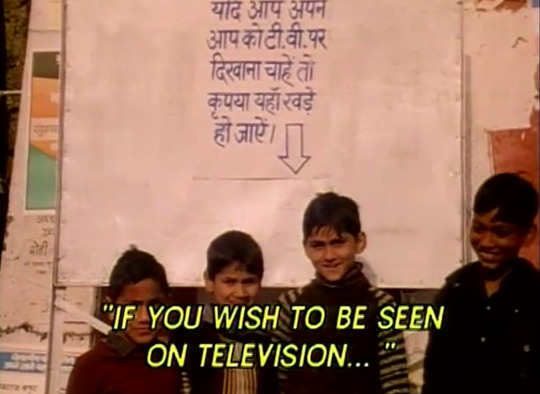
A still image from the end of Photo Wallahs - this still describes the authors process of the film and how he wanted to contrast and tie together still imagery and moving imagery as well as the view and meaning of photography in India
Is it an ethnographic film?
Yes and no. Macdougall acknowledges the ethnographic content the film holds. The film displays elements of Indian culture and how the interpret their culture ideologies while also utilizing and analyzing the photography produced. While these ethnocentric elements exist, the film is more than an ethnographic film. It has several layers at work. It is a film the displays photographic meaning from people through photography; this is an element shared across cultures as many art forms can also show this. The film does not “other” Indian culture or their use of photography. The film ultimately displays different ways of seeing and making sense of culture and photography involving both the participants and the audience.
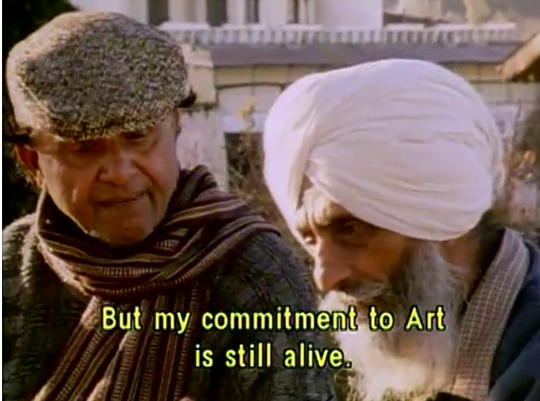
A still image from Photo Wallahs - This photo in particular I find great meaning in, out of all the ways photography was utilized by Indian culture in the film from income, recording history, a form of power, identification an documentation - it all comes back the basis of the existence of photography it is simply and art form for democratic use, and differences in interpretation and expression

0 notes
Text
Wide Angle Youth Media & The Baltimore Uprising Media Journal
Why are the authors arguing for not making an ethnographic film about Baltimore?
The publicity of Baltimore’s image has come under reproductions a multitude of times; which is evident in mass media and cinematic productions. The media sources classify Baltimore as a “dangerous space” and strengthen stereotypical assumptions and ideas that people inside and outside of Baltimore hold. This reinforcement of media makes it difficult for an audience to see what Baltimore means to its residents. Simply making an ethnographic film about Baltimore would contribute to the widely publicized view of Baltimore and not represent its realities. It would also further a power dynamic of researcher and subject relationship, which limits the image and message Baltimore residents want to reflect throughout media. Instead of reinforcing those factors, Baltimore residents were given the focus to reflect their image of Baltimore without influence on production.
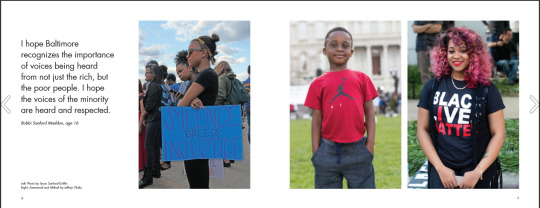
A series of photographs from Wide Angle Youth Media and This Is Baltimore
What do the authors mean when they say “push it along” regarding media?
“Push it along” refers to speaking alongside collaborators to showcase their representations of Baltimore, voice, and interpretations of the structural forces that produced the uprising. Regarding media, playing an active participatory role when using social media is accompanied with “push it along” and the media created by Baltimore’s youth. Wide Angle Youth Media, is a youth based group that creates alternative representations of Baltimore, it’s a prime example of “pushing it along.” Providing digital support by liking, sharing and commenting puts the alternative representations into the mediascape and stands alongside the negative stereotypes produced by other forms of media.

A series of photographs from Wide Angle Youth Media and This Is Baltimore
Wide Angle Youth Media creates alternative representations of Baltimore youth that challenge youth portrayal from authoritative media sources.
Discuss the process the authors advocate at the end of the article for engaging media and communities.
The authors suggest following the guidelines in their networked anthropology research, while also maintaining or developing your practices for a chosen platform, this include:
1. Have an engaging diverse network – inclusion of various friends, anthropologists, government officials, non-profits, and people and institutions that have a similar focus outside of your site in yours social media application.
2. Contribute regularly to social media, taking the time to learn the hashtag of importance to different communities.
3. Sending our a tweet containing media our primary goal is to promote someone else’s work. Acknowledge the creator and link the account accordingly. Provide a brief description to your followers and avoid interpretation – the goal is the promote the media and not your knowledge.
4. Add hashtags to connect the media with appropriate content; allowing the post findable by people attached to the topic.
5. The primary purpose is when retweeting, don’t change their message. Just pass it media along!
The interpretation of media is standard in sharing practices; this can compromise the original message from the creator. By just passing it along, the authors are advocating for an uninfluenced distribution of alternative representations of Baltimore.

A data visualization of #Baltimore tweets from Twitter - demonstrates the online social media presence Baltimore has
Safe Spaces & Wide Angle Youth Media
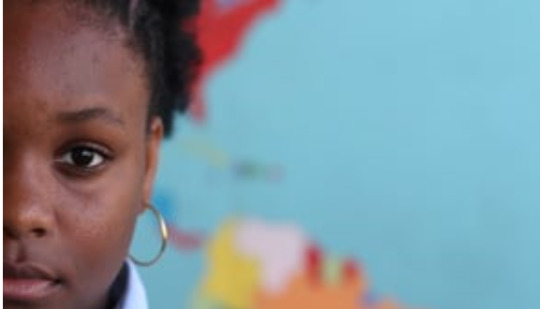
A still from the Safe Space video located on the Wide Angle Youth Media website
The beginning of the video showcases the kind and comical personalities of several middle school children from Wide Angle Youth Media. The middle-schoolers begin the video by listing things they love; including familiar associations to my life (sleep and pizza) and established the initial tone of the video. It begins as a heartwarming experience listening to the children smile and laughs while telling the audience what they love. There was a drastic shift when the kids started listing factors they do not like, and it comes as no surprise that violence is a major theme in the responses. The change in tone went from lighthearted to very real and striking. Upon further explanation, children experience up to 4 different forms of violence around the age of the children presented in the video. The presence of violence is commonly present in the youth lives today. In my personal experiences, I rarely hear the emotions or hardships coming from middle school-aged children. This invisibility is seen in the voices of our youth because “too young to know any better” when in reality, most children struggle with some inner-battle or violence. Passing this video along could assist the active voice of our City’s youth promoting all age group visibility.
2 notes
·
View notes
Text
Anthropology by The Wire Media Journal
Anthropology by the Wire:
The environments we encounter are not stable beings. Factors that contribute to this instability vary. The notion of instability can be applied to the environment in your proximity. The cities around you, institutions and neighborhoods possess their own aura. This aura is projected across space and consumed by outside forces. If asked, how would you describe your community? What if your representations did not match those of others? Perception and manipulation of an image contribute to misrepresentations of one’s space, character, and meaning. Baltimore is represented poorly in mainstream media. Its aura is viewed through a lens of violence, addiction, and stereotypes. The reproduction of Baltimore’s image is striped and fragmented then distributed across a mass media platform. This is visible through “real” depictions of Baltimore City portrayed in The Wire and Homicide. The “seedy” images do not match many positive representations Baltimore City neighborhoods, and communities hold. These representations take a toll on the community; producing negative consequences and effect community survival. The authorship and representation of the community are not held by the community. Instead, the media adopts authorship, reproduces images to fit their narrative and distributes them to the masses for consumption and interpretation.
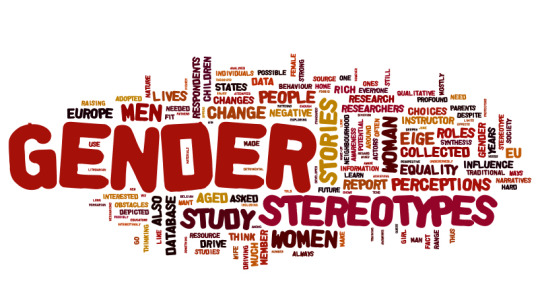
Infographic Courtesy of shoppertainmentmanagement.co.uk
This is where Anthropology by the Wire comes into the picture. Anthropology by the Wire is a multi-media research project on urban and visual anthropology in Baltimore (Durington & Collins). The program utilizes a collaborative research process that involves professors, students, and community members. Trough Networked Anthropology, community members, utilize multimodal forms of media to challenge power dynamics and take back authorship of their communities. The media produced is used to combat the negative and stereotypic narrative portrayed in media. The collaborative process benefits the community, students, and researchers. For the researchers, media provides information on Baltimore youth and how they answer anthropological questions. For students, it provides a reflexive process, fieldwork, and growth. For the community, media is used to promote their narrative and conquer those negative consequences from the negative representation. This directly relates to one of the main goals on Anthropology by the Wire. To produce collaborative research that develops and represents the city as a site of contested representation and identification, with the production of knowledge to help denizens of Baltimore’s neighborhoods to support their own self-representations (Durington & Collins). The media archive of both Sharp Leadenhall community and Anthropology by the Wire provides the narrative, experience, and evidence invested in the community and its residents.
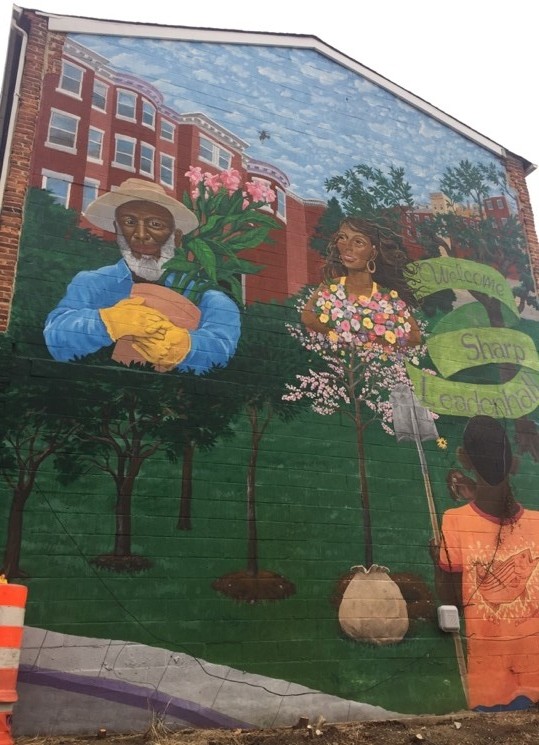
A photo by Amanda Gaster, 2016 from the Sharp Leadenhall Mobile Walking Tour
The Clean and Green Team video and Anthropology by the Wire:
The Clean and Green team video showcases the environmental upkeep one historic community employs. The Sharp Leadenhall Community is a historic African American community in Baltimore City. The community is in the center of a high foot traffic area. Both M&T Bank Stadium, Camden Yards and a light rail station surround it. These factors prove to be a challenge when maintaining the appearance of the community. The Sharp Leadenhall community acknowledge the amount of trash piling up in their neighborhoods. Betty Bland Thomas, a community resident, and Community Association President called for action to produce a solution. The Sharp-Leaden Hall Planning Committee assisted the help of Youthworks to develop a project that not only cleaned the streets but involved Baltimore City youth. Thus, the Clean and Green project began in Sharp-Leadenhall during the summer of 2011.
“This is a project that’s a win-win. Cleaning. Greening. And Healthy.”
– Betty Bland Thomas
During this time, Anthropology by the Wire had the opportunity to work collaboratively with this program. The collaboration spearheaded documenting the youth involved in the “Clean and Green Team” in Sharp-Leadenhall. The video gives the viewer personal accounts of various teenagers involved in the project. Throughout the video, you see how much they take pride in their neighborhood. Volunteers give their community a deep clean while promoting a positive influence to other community members. This relates to the Anthropology by the Wire literature concerning the representation of Baltimore City in media. Dominant representations of Baltimore are often shown in a negative light focused on violence, addiction, or The Wire. This is a different reality compared to some communities in Baltimore City. To combat these negative representation, Anthropology by the Wire utilizes collaborative media to help Baltimore neighborhoods and support self-representations. This is demonstrated through the collaborative process between researchers and community members. The teenagers involved are given cameras to record and actively portray their representations of Baltimore. They document their experience, community struggles, and community needs. Thus, the “Clean and Green Team” video was uploaded to YouTube.
“Our mission is to keep Sharp Leadenhall community clean…and try to get the community to take more pride in their neighborhood.”
– Sam McClennan

Volunteers of The Clean and Green Team video from Anthropology by the Wire, 2011
A Comparative Video: “Sharp Leadenhall Clean and Green 2014″
After binge-watching multiple videos in the archive, I chose a video that had two factors. The first factors relating to the reading. The second showing the progression of the Clean and Green program after establishment. The video takes place three years after the beginning of The Clean and Green program in the Sharp Leadenhall community. The video itself is stylized the same as the original. The volunteers are given cameras to document a “day in the life” style video. Directly involving the community members to document their narrative similar to the original process aids the collaborative method used by Anthropology by the Wire. Collecting data from the community members over time aids the collaborative process, community voice, and positive representation. We follow a group of teenage boys and see portions of their daily activities. These faces are unfamiliar this time around. The fresh faces display evidence of the expansion of the program. This was very exciting to the viewer. Throughout the demonstrated cleanup shots there are interviews with the boys. Each collaborator has a message to the public. The teenage boys in the video are passionate. Individual interviews convey community activism, environmental activism, and community pride. Not only does this promote taking care of one's community but also combats negative stereotypes portrayed by the media. This is strengthening the authorship of the Sharp Leadenhall community and its representation.
“We are coming together making other people happy, our parents happy and ourselves happy.”
- Will
There is an ongoing element of the collaborative research process between researchers, student, and community members. Actively involving all members is the essence of a network and collaboration. The activism for the community seen as well as the expansion of the program is directly related to Anthropology by the Wire-reading. The videos support the intention of Anthropology by the Wire. The research produced collaboratively also assist the community. Anthropology by the Wire has a goal to create a realistic portrayal of Baltimore City communities to use as a historical record, combat negative representation, and a tool to enhance their community. The people behind the lens and those in front of it coexist and produce meaningful content and messages. This collaboration between the researchers, students, and community create positivity in a slew of misrepresentation of Baltimore City.
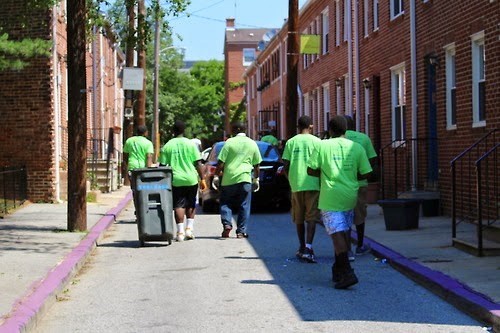
Photograph of Green Team Volunteers from The Dirt About Trash in the City, Klaus Philipsen 2014
2 notes
·
View notes